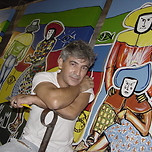
Discover the contemporary work of Claudyo CASARES

The artist moves through history of art and creates mysterious images which stuck into our heads. They are cubist figures from Picassos´swork, all put together in one only image.The colorful forms which are the basis of his paintings create diagrams with colors and forms which remind us the Byzantine stained glass-windows. In an endless search, the artist studies Picasso and Matisse figures and the geometry of Mondrian. Casares view of those pieces of art, confirms his job quality, and his search for knowledge is merely an act of noblesse, once he takes less risks when he bases his work in such great masters? references. He can?t be considered a regional artist because his restless mind leads him beyond country boarders; he?s plugged to the world.Globalization may still not be a reality in his life, but this new form of imperialism (this intellectual domination) can be perceived in hisstyle through which we can tell the walking spirit of the artist.This contamination can also be seen in his works, through the incorporation of different images representing the cultures he hasalready known. In his painting ?Guernica- nightmare that never finishes?, the symbols of the holocaust are the same evil mentors who inflict physical and mental pain to the contemporary world. ?The cows of marshland?, other painting in homage to Picasso, was idealized based on the origami ( a Japanese paper-folding art) and having the walls of Chapada dos Guimarães as a background. In his paintings Gatonças, ?The feline courtship? and ?The dance of fish?, in honor to Mato Grosso state, he represents the typical elements of its geography like Cuiaba River and Santo Antonio Hill. The series ? The dance of masked?, beyond the reference to the popular culture from the local natives, highlights a typical musical instrument called viola de cocho and it suggests an intercultural dialogue through the masks of the movie idols Batman and Robin. The painting ?Cock? with his corkscrew form peak and ?Accordion man? reflects his memories of the time he lived in Portuguese lands. By producing his own Pietá, the artist mocks the pain caused by the economical and cultural differences: a homeless woman holding her son. Mother and child cry their hearts out standing at a palace door represented by an icon of the local culture: Santo Antonio Hill. Behind the people the viewer can read a sign which says: Smile! You?re on camera. The globalization is also a theme of his morbid side. In ?Dinner of globalization?, human heads are served to be eaten with knives and forks. On the other hand, he?s got a romantic- poetic side. In?Harmony in red?, Casares creates a perfect matching of red and blue enriched by the lights of the white chairs; and through the window, instead of the cold Russian landscape, he painted the sea view from his studio in Lisbon. His women are his own doubts. His eyes recreate the questions of art and it?s through them that the world is perceived. It?s like the artist could see through the lenses of such a complexity, in the look of one of the characters ?Les Demoiselles d?Avignon?. Watching and analyzing the art is art itself. He?s inside and outside the paintings at the same time. The sensuality of the female body, in some of his paintings, is so simply and safely represented, that it doesn?t shock or seduce us; it simply leads us to a new perspective of the picture. The Portrait of Bela is a proof of this. One thing we can?t deny is the exuberance of the colors he uses in their primary tones which proves the artist?s talent for painting. His monochromatic picture, exposed in ?Casa Cor 2000?(an architecture and decoration show room), confirms this. A combination of nearly pure colors which create a graphic environment where the elements which form it, are stuck to a colorful field. Its drawing is idealized and designed all over the canvas. The artist commands the traces, however, as far as I?m concerned, those traces are merely an exercise to imprison thetheme; actually, his endless search is about a superposition of the elements of colors.






































































